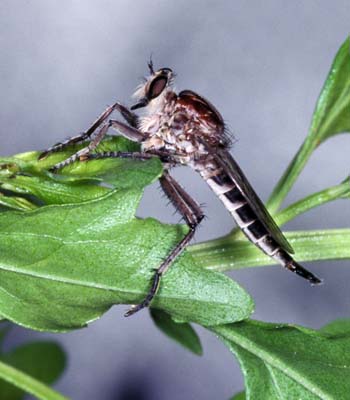
Adult robber fly, unidentified species.
(Photographer: Lyle Buss, University of Florida)
Males and females of the same species are similar in appearance, except that some females have broader abdomens than males. Robber flies are usually brown, gray or black in color, and have a characteristic depression on the top of their head. Many species resemble bees in appearance. They have hairy faces and flattened heads. The body of these flies can either be elongate and slender with a tapering abdomen, or stout and hairy. Robber flies range from 0.3 cm to 3.0 cm in length. The legs of these flies are long, as well as strong, which helps in capturing prey.
The life cycle of robber flies may span from one to three years, depending on the species and environmental conditions. Female robber flies lay their whitish-colored eggs in masses and cover them with a chalky coating. The larvae live in the soil and pupate in the last larval skin. Emerging adults then dig their way to the soil surface.
These flies prefer arid and sunny habitats near clearings in and around the edge of woods, on sand near water, in open fields, on fallen trees and on fences throughout the United States.
Robber fly larvae prey upon the immature stages of many other insects. Adult robber flies feed on other flies, beetles, various bees, moths and butterflies, dragonflies and damselflies, grasshoppers and some spiders.
Images
To save the Web-optimized images shown below to your hard drive:
|
Click to access Display and Print quality images. |
|
Click to access Display and Print quality images. |